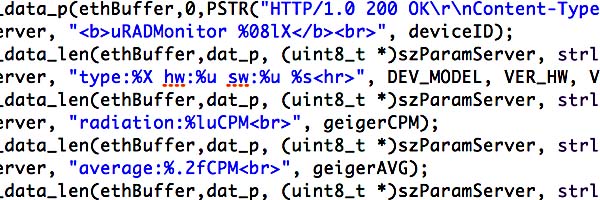
With the uRADMonitor network covering more ground, constant effort is invested in making the project serve its purpose better. Code improvements come with extra features or better stability, and new firmware updates are released to anyone interested in upgrading their units.
Firmware 111 is the latest code released for the uRADMonitor model A units. We are excited to announce a set of changes that is the start of several improvements impacting both the hardware devices and the server infrastructure.

RESTful APIs. Easy to understand, maintain and extend, this will handle all data interfacing. This is also a first step in supporting custom DIY detector units that wish to join the uRADMonitor network, in an effort of expanding Global coverage even faster.
in compliance with the new API, we’ll use HTTP POST requests for all unit data uploads, while we reserve HTTP GET transactions mostly for data access part of the new API. New Standards are getting in place.
Encryption and integrity control. In early versions all resources were invested in getting the job done, and ignored the possibility of cybernetic attacks. Since this is not a perfect world in regards to people with bad intentions, and to protect the integrity of the data we deliver – firmware v111 is the first to integrate advanced encryption techniques, to make sure the data sent from the uRADMonitor units arrives unaltered to the servers.
embedded code improvements to speed, memory size and stability, as well as some bug fixes related to JSON formatting and temperature readings.
To get the new firmware, get in touch! Instructions on how to upgrade are available here.


I’m seriously happy to hear about these updates, especially the encryption. Another frontier I would like to see is the publication of the protocol so that home-made monitors can join the network. Monitors made by other makers can be calibrated by being placed with a uRADmonitor for a time to establish it’s offset. Uncalibrated monitors can still supply useful data by studying it’s relative level measurements, and sudden changes from historically established levels. Email alerts would be appreciated, both for alarming spikes, as well as crossing long-term exposure thresholds.
Thanks for the valid arguments, Seth. The new RESTful API is planned to serve this purpose as well, to provide an interface for custom / homemade / DIY monitors. More details will be published soon.
salut!
felicitari pt aceasta initiativa faina!
ma intereseaza si pe mine un astfel de aparat. am niste intrebari:
-ce radiatii masoara (gamma, x, beta, alfa)
-ce alti sensori mai are (temperatura, umiditate, poluare, etc?)
-ce precizie are si care sunt valorile min/max care poate sa masoara?
-se poate lega direct pe un router, sau e musai sa fie legat pe un pc?
-ai si modele portabile cu display, sau eventual ceva ce se poate conecta cu un android (prin bluetooth sau wifi)?
multumesc,
o zi buna!